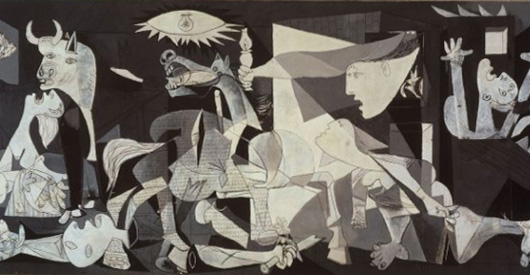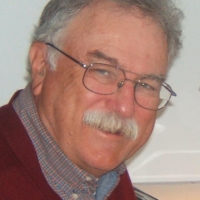
Danny Watt took me to see Guernica when it was on display at the Museum of Modern Art in New York in the spring of 1959. It was a natural for Danny because his father was George Watt, a beloved veteran of the Abraham Lincoln Brigade who had fought as a volunteer against Franco fascism in Spain.
Danny, who had grown up in a cramped apartment on Tremont Ave. in the Bronx had come to visit us on our dairy farm in Sequim, Washington. Breathing the clean, fresh air of Clallam County, gazing at the snowcapped Olympic Mountains, had been a marvelous experience for Danny and now he was returning the favor, showing off his home town to me.
I had come down to New York City from Amherst College where I was a freshman suffering agonies of homesickness, failing the required Math-Science course.
The two hours I spent sitting on that museum bench looking at Guernica was the most instructive moment of that visit. It is a very large painting, a very black and white canvas, a very stark and unforgiving image of murderous Nazi mutilation.
It is also a highly symbolic painting and the symbols are mystifying. There is the bull standing near the center of the canvas, his mouth open, his tongue out, as if frozen by the horror that surrounds him. Just beneath him is a mother, her head thrown back, holding the remains of her dismembered child. There is a long corpse lying flat along the bottom of the canvas. A horse, also disemboweled, has his head thrown straight up, screaming. The canvas is covered with a confused mass of body parts—as if a bomb, or more than one, has torn life itself into shreds.
Flying in the open door, her eyes full of anguish, her arm outstretched toward the bull, is a woman holding a lamp.
This is Pablo Picasso’s rendering of the genocidal crimes of Hitler’s Condor Legion in its carpet bombing of the Basque city of Guernica, April 26, 1937. The Basque government reported that 1,564 women, children and men died in this totally unprovoked attack on an undefended city.
Picasso’s painting became a symbol of the struggle against fascism and imperialist war.
The mural-sized painting was first exhibited in Paris, then taken on a brief world-wide tour before ending up at the Museum of Modern Art. Picasso had made clear the painting was not to be delivered to Spain until after democracy was restored to that tortured nation. When Franco died and the fascist dictatorship was abolished, Guernica was sent to Spain. It is now exhibited at the Museo Reina Sofia in Madrid.
In the autumn of 1963, I returned to Amherst College with my wife Joyce and our infant son, Morgan. A classmate, Dick Stein, lived upstairs from our off-campus apartment. He and his partner, Carole, became close friends.
As I was trying to decide what courses to take, Dick suggested Dr. Frank Trapp’s Art History course. He had high praise for Trapp. He had taken one of Trapp’s courses and was signing up for another one. I took his advice.
Trapp’s method was to project slides of paintings, drawings, statues, and architectural masterpieces on a giant screen and then talk about them. He was a marvelous teacher with deep insights into the meaning of the art he lectured about.
Trapp was lecturing on great art of the 20th Century offering insights into the genius of the French Impressionists, the post-Impressionists, the Expressionists, up to the period of modern, non-objective art.
Then one day, he flashed on the screen Guernica, full size.
He began to speak about the painting: the chaos, the disemboweled body parts flung on the canvas, the grim black, white, and gray color scheme, Picasso’s refusal to give us any refuge in a well-ordered, easily understood reality.
Trapp argued that the bull symbolized the vicious brutality of the bombing attack, the face of fascism. The bull had charged into the room wreaking havoc, goring men, women and children left and right, leaving the dead and dying all around him.
I raised my hand. “No, no,” I said. “That can’t be right. There is no way Picasso would surrender the bull, a symbol of Spain, to the fascists. No. The bull is standing in the midst of the carnage, frozen, unable to act. He is a symbol of the Spanish people, confused by the mass destruction around him but also enraged, his tongue out, bellowing with anger. And see to the right, flying in the window, is a woman holding a lamp, the spirit of enlightenment. She is trying to reach the bull to bring understanding. It is Picasso’s message that once the woman with the lamp reaches the masses of the people —represented by the bull—- then you have an invincible force that will defeat the fascists.”
As I spoke, I heard Trapp in the darkened auditorium exclaiming, “Yes! Yes! You are right. I see it now!”
When the class was over, Dick and I walked back to our apartments together. “That was great, Tim. Your interpretation of Guernica was a real eye opener.”
That was a high point of my years at Amherst College. Learning to see Guernica through clear eyes, understanding what the great Pablo Picasso was telling us about the struggle to defeat fascism. I have carried that lesson with me my entire life.
Photo: Wikipedia (CC)

MOST POPULAR TODAY

High Court essentially bans demonstrations, freedom of assembly in Deep South

Zionist organizations leading campaign to stop ceasefire resolutions in D.C. area

U.S. imperialism’s ‘ironclad’ support for Israel increases fascist danger at home

UN warns that Israel is still blocking humanitarian aid to Gaza







Comments